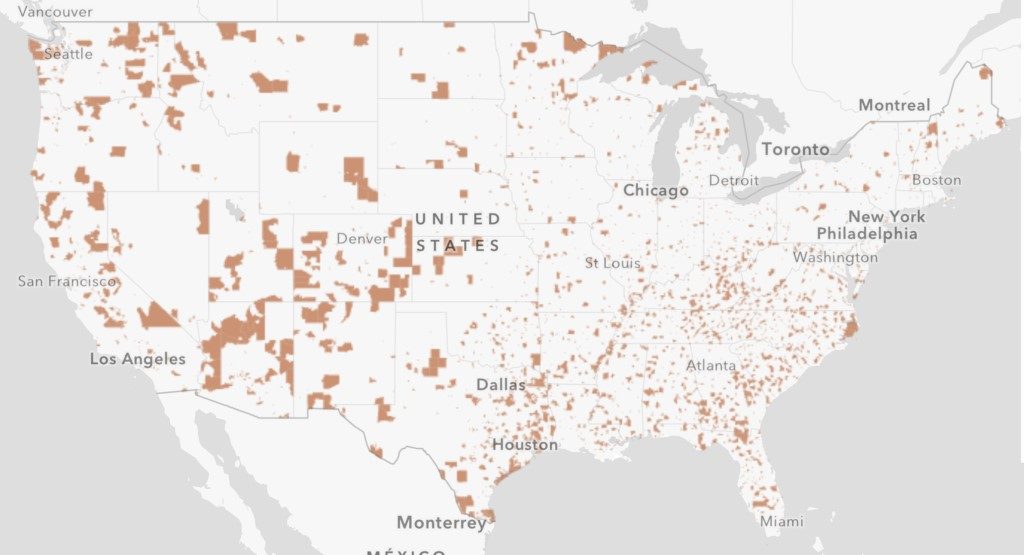5 Strategies to Prepare Opportunity Zones for Development
David Robinson.
The Montrose Group, LLC.
The waiting is painful. The U.S. Treasury Department has certified over 8700 census tracts across the United States as Opportunity Zones. Through a comprehensive public engagement process the nation’s Governors recommended eligible census tracts and the Treasury all according to the required statutory deadline certified the Opportunity Zone census tracts across the U.S. that can qualify for a substantial federal capital gains deferral.
According to the Economic Innovation Group, the certified Opportunity Zones have an average poverty rate of nearly 31 percent, well above the 20 percent eligibility threshold, and an average median family income of only 59 percent of its area median, compared to the 80 percent eligibility threshold, but these zones may well be positioned to succeed economically as they contain 24 M jobs and 1.6 M places of business and three-quarters of zones are located in zip codes that experienced at least some level of post-recession employment growth from 2011 to 2015.
Certified Federal Opportunity Zone Map

Source: Economic Innovation Group
While the U.S. Treasury Department is expected to promulgate the final Opportunity Zone rules needed to formally launch an Opportunity Zone, communities and property owners can prepare their Opportunity Zones now with steps critical to make the site an economic success. The reality is not all Opportunity Zones are born alike and local and state governments, economic development leaders and the property owners can all play a large role in making their site attractive to investors. Key steps communities and property owners should taken include:
- Site Plans. Opportunity Zone owners and/or the communities promoting them need to develop a site infrastructure plan that includes not just the infrastructure and transportation study but also to review the likely industries to succeed at this site and how the infrastructure and transportation costs can be funded. The more “job ready” an Opportunity Zone site the more likely it has a strong chance of attracting investors.
- Land Use Entitlements. Based upon the site development plan, Opportunity Zone sites should proceed with the zoning, water and sewer agreements and other land use entitlements needed to make the site operational.
- Tax Incentives. No doubt part of any Opportunity Zone site plan will be recommendations for the site to gain the needed tax incentives- abatements, credits, Tax Increment Financing, grants or loans needed for the site to succeed. Developers or community leaders need not wait for the final Treasury Department rules to be announced to advocate for the local government to place needed tax incentives at the site.
- Infrastructure Funding. Another critical part of a site plan is the identification of the infrastructure needs and the sources of funding. Gaining the funding for an Opportunity Zone’s necessary infrastructure and building the infrastructure is another site development step that does not need to wait for the final regulatory approvals.
- State Advocacy Agenda. Early wins for the Opportunity Zone program will likely have state government leadership that works to align state government tax policy with the federal law in their state’s Opportunity Zones. A suggested state advocacy agenda for Opportunity Zones could include:
a. Opportunity Zone Council. State government leaders need to coordinate the public and private sector partners interested in the success of Opportunity Zones into a state council where best practices and a common public policy agenda can be developed and advocated for.
b. Opportunity Zone Summit. State government leaders should convene all the owners and local governments interested in developing Opportunity Zones at an annual Opportunity Zone Summit to promote best practices and to build public and private support for developments in the Opportunity Zones.
c. Advocacy Agenda. Based upon the feedback of local communities and property owners and developers of Opportunity Zones, a public policy agenda to promote the use of Opportunity Zones should be created that can address:
i. Common Tax Code. State capital gains taxes should be removed from all Opportunity Zones to maximize the financial attractiveness of the site.
ii. Opportunity Zone Economic Development Corporation. A new not-for-profit economic development corporation could be permitted by state government that grants all the powers of an Ohio port authority to an organization formed to develop a federal government designated Opportunity Zone.
iii. Opportunity Zone Infrastructure Grants. State governments should be encouraged to develop specific infrastructure funding tied to the development of their Opportunity Zones.
OEDA Quarterly Report – Q2 2025
April 1 – June 30, 2025 From Expansion to Execution: OEDA’s Q2 2025 in Review OEDA’s second quarter was marked by continued momentum across our strategic pillars—membership, programming, partnerships, and advocacy. With a growing and increasingly engaged network, a...
OEDA Congratulates Graduates of the 2025 Ohio Basic Economic Development Course
OEDA Congratulates Graduates of the 2025 Ohio Basic Economic Development Course DUBLIN, OH – The Ohio Economic Development Association (OEDA) proudly congratulates the more than 85 participants who successfully completed the 2025 Ohio Basic Economic Development Course...
OEDA Begins Strategic Planning Amid Record Growth + Program Expansion
FOR IMMEDIATE RELEASE RFP now open for OEDA’s next strategic plan; proposals due July 1, 2025 COLUMBUS, OH; Tuesday, June 3, 2025 — The Ohio Economic Development Association (OEDA) has released a Request for Proposals (RFP) to develop a new strategic plan, its first...